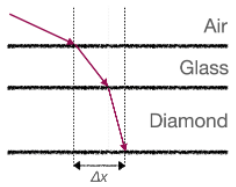Navigation » List of Schools, Subjects, and Courses » Physics 106 – Algebra-Based Physics » Tests » Chapter 18 Test
With Answers Good news! We are showing you only an excerpt of our suggested answer to this question. Should you need our help in customizing an answer to this question, feel free to send us an email at  or chat with our customer service representative.
or chat with our customer service representative.
Chapter 18 Test
Chapter 18 Test
1. You’ve been given the task of testing a new optical device for an undisclosed purpose. (Perhaps you work for a three-letter government agency?) You’re given a flat slab of material and told that it’s made of a 0.91 cm thick layer of a glass with nglass = 1.50 sitting atop a 0.97 cm thick layer of diamond with ndiamond = 2.42. Your job is to test the slab to see if it could actually be made of these materials with these indices of refraction.
Being a clever physicist, you come up with the ingenious idea that you can test to see if a laser incident at some angle with respect to the normal of the air/glass interface emerges at the predicted location after passing through the “diamond.” You start by shining a 639 nm laser at an incident angle of \theta =θ= 59.7º with respect to the normal.
What is the predicted horizontal distance traveled through the material, \Delta xΔx, based upon the information given above? Give your answer in centimeters rounded to a reasonable number of significant figures. Do not include the units in the answer box. Assume you know all given values to three significant figures.

2. When you perform the test described in Part 1, you find that the actual measured value of \Delta xΔx is greater than the value you had predicted. Which of the following options could, entirely on its own, provide an explanation for this discrepancy? Select all that apply.

